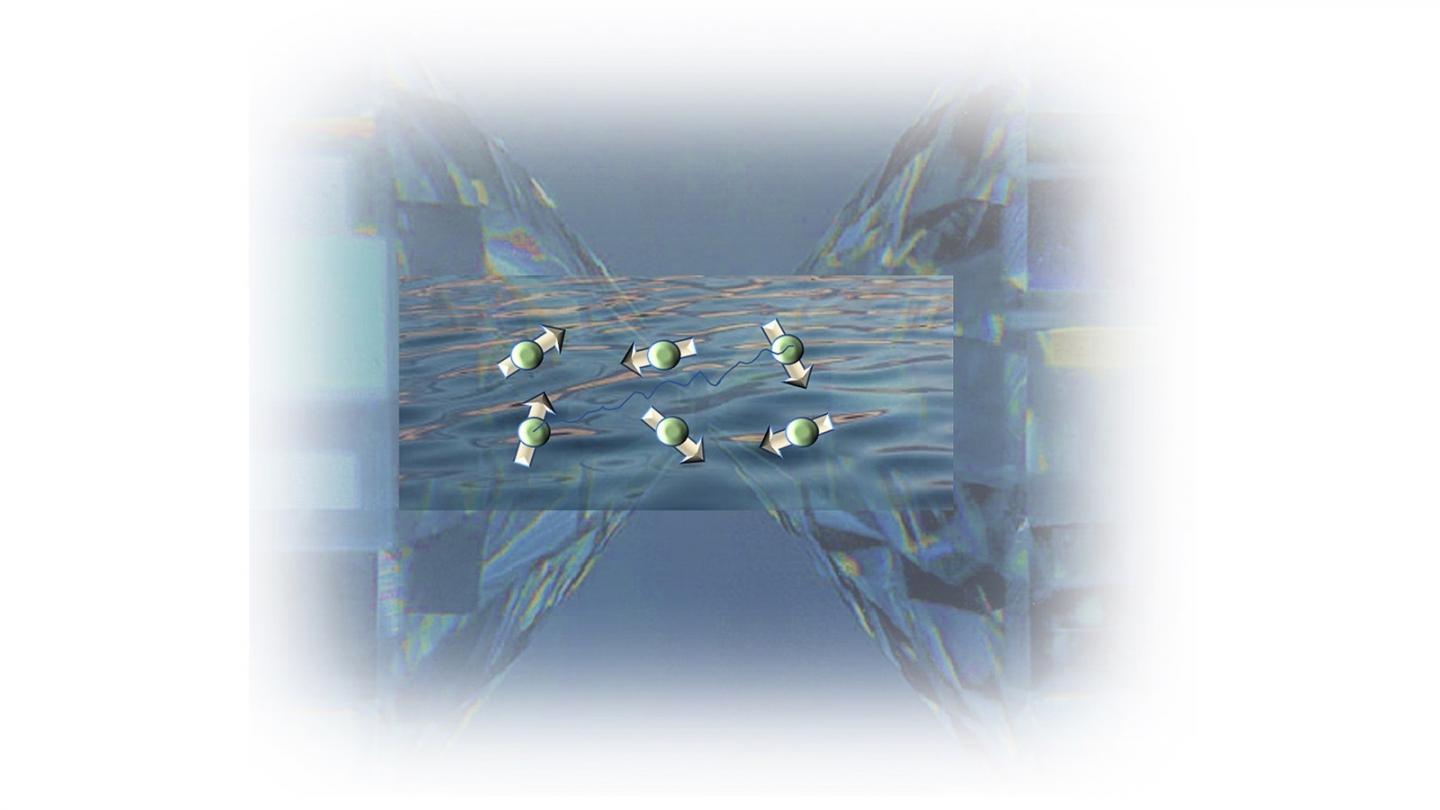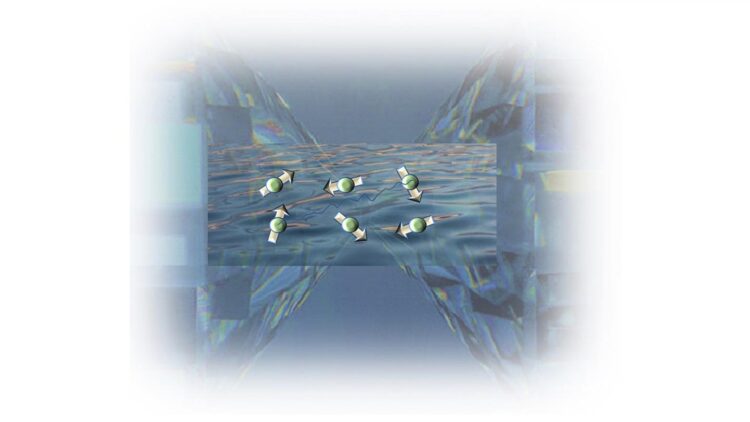
Credit: Daniel Haskel
It sounds like a riddle: What do you get if you take two small diamonds, put a small magnetic crystal between them and squeeze them together very slowly?
The answer is a magnetic liquid, which seems counterintuitive. Liquids become solids under pressure, but not generally the other way around. But this unusual pivotal discovery, unveiled by a team of researchers working at the Advanced Photon Source (APS), a U.S. Department of Energy (DOE) Office of Science User Facility at DOE’s Argonne National Laboratory, may provide scientists with new insight into high-temperature superconductivity and quantum computing.
Though scientists and engineers have been making use of superconducting materials for decades, the exact process by which high-temperature superconductors conduct electricity without resistance remains a quantum mechanical mystery. The telltale signs of a superconductor are a loss of resistance and a loss of magnetism. High-temperature superconductors can operate at temperatures above those of liquid nitrogen (−320 degrees Fahrenheit), making them attractive for lossless transmission lines in power grids and other applications in the energy sector.
But no one really knows how high-temperature superconductors achieve this state. This knowledge is needed to increase these materials’ operating temperature towards ambient temperature, something that would be required for full-scale implementation of superconductors in energy-conserving power grids.
“A quantum spin liquid is a superposition of spin states, fluctuating but entangled. It’s fair to say that this process, should it create a quantum spin liquid with quantum superposition, will have made a qubit, the basic building block of a quantum computer.” — Daniel Haskel, physicist and group leader, XSD
One idea put forth in 1987 by the late theorist Phil Anderson of Princeton University involves putting materials into a quantum spin liquid state, which Anderson proposed could lead to high-temperature superconductivity. The key is the spins of the electrons in each of the material’s atoms, which under certain conditions can be nudged into a state where they become “frustrated” and unable to arrange themselves into an ordered pattern.
To relieve this frustration, electron spin directions fluctuate in time, only aligning with neighboring spins for short periods of time, like a liquid. It is these fluctuations that may aid in the electron pair formation needed for high-temperature superconductivity.
Pressure provides a way to “tune” the separation between electron spins and drive a magnet into a frustrated state where magnetism goes away at a certain pressure and a spin liquid emerges, according to Daniel Haskel, the physicist and group leader in Argonne’s X-ray Science Division (XSD) who led a research team through a series of experiments at the APS to do just that. The team included Argonne assistant physicist Gilberto Fabbris and physicists Jong-Woo Kim and Jung Ho Kim, all of XSD.
Haskel is careful to say that his team’s results, recently published in Physical Review Letters, do not conclusively demonstrate the quantum nature of the spin liquid state, in which the atomic spins would continue to move even at absolute zero temperatures — more experiments would be needed to confirm that.
But they do show that, by applying slow and steady pressure, some magnetic materials can be pushed into a state similar to a liquid, in which the electron spins become disordered and magnetism disappears, while preserving the crystalline arrangement of the atoms hosting the electron spins. Researchers are confident they have created a spin liquid, in which the electron spins are disordered, but are not certain if those spins are entangled, which would be a sign of a quantum spin liquid.
If this is a quantum spin liquid, Haskel said, the ability to create one by this method would have wide implications.
“Some types of quantum spin liquids can enable error-free quantum computing,” Haskel said. “A quantum spin liquid is a superposition of spin states, fluctuating but entangled. It’s fair to say that this process, should it create a quantum spin liquid with quantum superposition, will have made a qubit, the basic building block of a quantum computer.”
So what did the team do, and how did they do it? That brings us back to the diamonds, part of a unique experimental setup at the APS. Researchers used two diamond anvils, cut in a similar way to what you’d see in jewelry stores, with a wide base and a narrower, flat edge. They positioned the smaller flat edges together, inserted a sample of magnetic material (in this case a strontium-iridium alloy) between them, and pushed.
“The idea is that as you pressurize it, it brings the atoms closer together,” said Fabbris. “And since we can do that slowly, we can do that continuously, and we can measure the properties of the sample as we go up in pressure.”
When Fabbris says that pressure was applied slowly, he isn’t kidding — each one of these experiments took about a week, he said, using a sample of about 100 microns in diameter, or about the width of a thin sheet of paper. Since researchers didn’t know at what pressure magnetism would disappear, they had to carefully measure with each very slight increase.
And see it disappear they did, at around 20 gigapascals — equivalent to 200,000 atmospheres, or about 200 times more pressure than can be found at the bottom of the Mariana Trench in the Pacific Ocean, the deepest trench on Earth. The spins of the electrons remained correlated over short distances, like a liquid, but remained disordered even at temperatures as low as 1.5 Kelvin (−457 degrees Fahrenheit).
The trick, Haskel said — and the key to creating a spin liquid state — was to preserve the crystalline order and symmetry of the atomic arrangement, since the unwanted effect of random disorder in atomic positions would have led to a different magnetic state, one without the unique properties of the spin liquid state. Haskel likens the electron spins to neighbors on a city block — as they get closer, they all want to make each other happy, changing their spin direction to match their neighbors’. The goal is to get them so close together that they cannot possibly keep all of their neighbors happy, thereby “frustrating” their spin interactions, while still maintaining the structure of the city block.
The research team used the intense X-ray imaging capabilities of the APS to measure the magnetism of the sample, and according to Haskel and Fabbris, the APS is the only facility in the United States where such an experiment could be done. In particular, Fabbris said, the ability to focus in on one type of atom, ignoring all others, was crucial.
“The samples are very small, and if you try to measure magnetism with other techniques in a university lab, you will pick up the magnetic signal from components in the diamond anvil cell,” Fabbris said. “The measurements we did are impossible without a light source like the APS. It is uniquely capable of this.”
Now that the team has achieved a spin liquid state, what’s next? More experimentation is needed to see if a quantum spin liquid has been created. Future experiments will involve probing the nature of spin dynamics and correlations more directly in the spin liquid state. But the recent results, Haskel said, provide a path for realizing these elusive quantum states, one that could lead to new insights into superconductivity and quantum information sciences.
Haskel also pointed forward to the APS Upgrade, a massive project that will see the instrument’s brightness increased up to 1,000 times. This, he said, will allow for much deeper probes into these fascinating states of matter.
“It’s up to anyone’s imagination which surprising quantum mechanical effects are waiting to be discovered,” he said.
###
About the Advanced Photon Source
The U. S. Department of Energy Office of Science’s Advanced Photon Source (APS) at Argonne National Laboratory is one of the world’s most productive X-ray light source facilities. The APS provides high-brightness X-ray beams to a diverse community of researchers in materials science, chemistry, condensed matter physics, the life and environmental sciences, and applied research. These X-rays are ideally suited for explorations of materials and biological structures; elemental distribution; chemical, magnetic, electronic states; and a wide range of technologically important engineering systems from batteries to fuel injector sprays, all of which are the foundations of our nation’s economic, technological, and physical well-being. Each year, more than 5,000 researchers use the APS to produce over 2,000 publications detailing impactful discoveries, and solve more vital biological protein structures than users of any other X-ray light source research facility. APS scientists and engineers innovate technology that is at the heart of advancing accelerator and light-source operations. This includes the insertion devices that produce extreme-brightness X-rays prized by researchers, lenses that focus the X-rays down to a few nanometers, instrumentation that maximizes the way the X-rays interact with samples being studied, and software that gathers and manages the massive quantity of data resulting from discovery research at the APS.
This research used resources of the Advanced Photon Source, a U.S. DOE Office of Science User Facility operated for the DOE Office of Science by Argonne National Laboratory under Contract No. DE-AC02-06CH11357.
Argonne National Laboratory seeks solutions to pressing national problems in science and technology. The nation’s first national laboratory, Argonne conducts leading-edge basic and applied scientific research in virtually every scientific discipline. Argonne researchers work closely with researchers from hundreds of companies, universities, and federal, state and municipal agencies to help them solve their specific problems, advance America’s scientific leadership and prepare the nation for a better future. With employees from more than 60 nations, Argonne is managed by UChicago Argonne, LLC for the U.S. Department of Energy’s Office of Science.
The U.S. Department of Energy’s Office of Science is the single largest supporter of basic research in the physical sciences in the United States and is working to address some of the most pressing challenges of our time. For more information, visit https:/
Media Contact
Beth Schlesinger
[email protected]
Original Source
https:/
Related Journal Article
http://dx.





